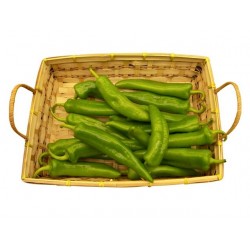



Anaheim is a Mexican chilli variety, which was taken to Anaheim in California and established as a separate variety from other Mexican chillies. The variety was developed to have milder taste and larger fruits. It is a green pepper, maturing to red, and the fruits can reach 20 cm in length and 4 cm in width, tapering to a point. A meaty chilli which is excellent for stuffing and to garnish any Mexican dish.
When it's cold outside and you are yearning for spring so you can get your garden started, don't fret, plant chilli peppers! These long season, heat-craving, hot little peppers need to be started as far in advance as possible. January or February is ideal. They'll need some attention, even a little babying.
Growing chilli peppers is a lot of fun. The variety of colors alone are captivating enough, then you have flavors and heat and types to consider. Soon enough, you might find yourself with hot pepper plants on all your windowsills. You may just find yourself getting hooked on these little plants.
Chilli peppers come in a wide array of colors, sizes, varieties, and, of course, heat. Read up on the different ones and pick one that best suits your needs. The seed packets will all indicate just how hot the peppers are so make sure you read them closely. An unexpected mouth numbing hot pepper is not the best surprise.
In general, the hottest peppers require the longest growing season. Keep this in mind when figuring out when you intend to plant and whether there is enough of a season in your area for them to come to full maturity.
Planting
The most important thing to know about growing chillis is that they need warmth. Chilli plants will not thrive in cold weather. They need at least 26C during the day and at the lowest, 15C at night.
Start chilli peppers in small pots or trays filled with rich, moist, soil in January or February, depending on the chilli variety you are planting. Plant a few chilli seeds shallowly in a pot, or if in a tray, 2-3 inches apart in rows. It is highly recommended to use a heated propagator to encourage the seeds growth. Also, you could use a warm airing cupboard, sheltering the pots with a plastic bag. The propagator should be set to 18-25C underneath the seed trays until they germinate. This takes 7-10 days. Water the seedlings daily, keeping the soil moist but not drenched.
When the peppers are about 2 inches tall, 4-6 weeks after planting, transplant the seedlings to individual pots. Then, after another 4-6 weeks, move them to larger pots or transplant them outdoors.
Greenhouse vs. Garden
The ideal place for these seedlings is in a greenhouse. Gardens in cooler temperatures will still be able to grow the peppers, however you will see stunted or slowed growth and the peppers will probably not get as hot as they should. This, of course, negates the whole point of planting them. What are hot peppers without the heat?
Keeping the seedlings in larger, 6-10 inch pots, makes them easy to move around to sunlit windows and then into a greenhouse. Chilli pepper seedlings do best when they are on a raised up platform or on a bench in the greenhouse. If they are placed on the ground, they are susceptible to cool drafts and being eclipsed by larger plants who will steal their sunlight. Pick a bright sunny unobstructed spot for these plants.
If you don't have access to a greenhouse, you can also plant hot peppers in your garden when all danger of frost is gone. In this circumstance, it is best to choose a hot pepper variety with a shorter grow time to be sure it will reach maturity, or at least as close as possible.
Find the sunniest spot possible to plant these little seedlings. There shouldn't be any shade at all. Be careful if you are planting other seeds or seedlings nearby because as they grow, their leaves may overshadow the little chilli pepper plants. Transplant in a row, 2 feet apart and with several feet between rows. Hot pepper plants need plenty of space on either side of them to bush out.
With both these methods, greenhouse or garden transplant, harden the plants beforehand. When the outdoor climate is warmer, place them outside for a few hours each day, increasing the amount time as you go, over a period of a couple weeks. This will slowly acclimate the sensitive plants to the cooler outside weather.
Watering & Care
Chilli peppers need to be watered regularly. Soak the soil around the edges of the plants just enough so the soil is wet without being drenched. Over-watering can cause the plant's roots to rot. Do not let your pepper plants wilt. This will affect their quality and harvest.
When your plants grow their first flowering shoots, pinch them off at the tip. This encourages the plants to branch out more and will increase your yield.
Harvesting
Chilli peppers gain heat as they grow. They can be picked when they are green and will have a milder bite. Use scissors to snip the peppers off individually. Also, wear gloves or wash your hands thoroughly. Any accidental rubbing of the eyes after handling these can cause extreme irritation.
If you have your hot peppers in pots and find the season growing colder before you plants are fully mature, bring them inside. A warm, sunny, windowsill should help. For pepper plants that have been planted to your garden, they will need to be harvested before the last frost, regardless of whether they have reached full maturity. They will still be good to eat and use for cooking, however they may not have taken on their final full color or heat yet.